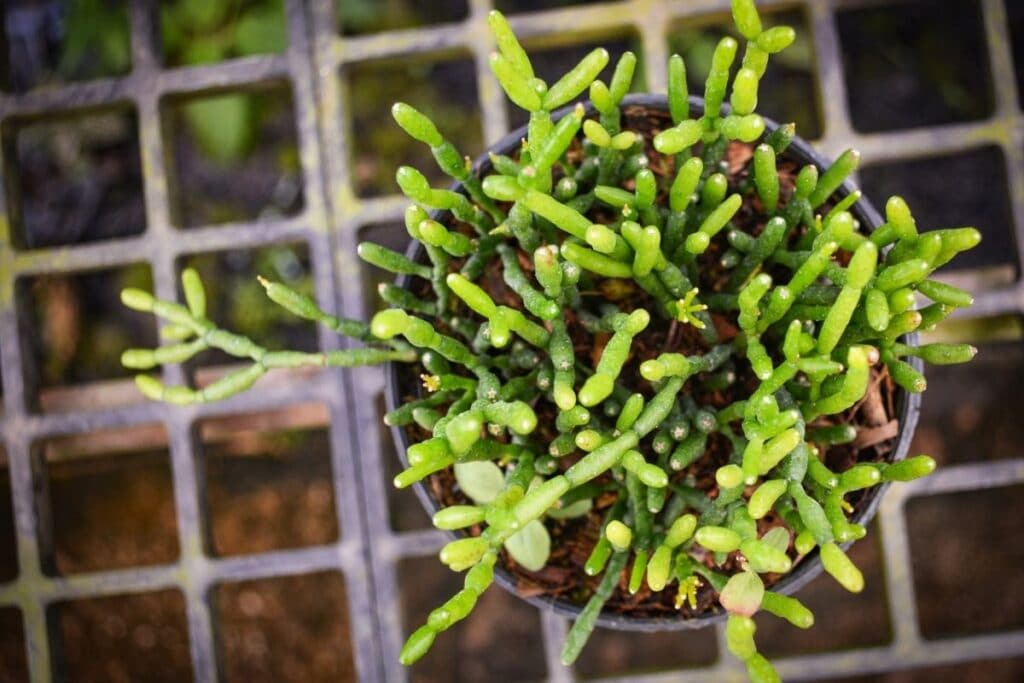Cacti are known for their prickly and rigid appearance making them excellent statement plants in the house. But there are some types that look less like a cactus which makes them even more exceptional. A good example is the Coral cactus.
What Is A Coral Cactus?
The Coral Cactus is a cultivar of Euphorbia lactea, scientifically known as Rhipsalis cereuscula in reference to the interlacing candle-like waxy stems of the plant. The common name is derived from its green coral-like shrubby growth. Other synonyms are Erythrorhipsalis cereuscula, mistletoe cactus, crested euphoria, crested candelabra plant and rice cactus.
This cactus is epiphytic in nature and is originally found in the jungles of Brazil (1). Unlike desert cacti, it has cylindrical branching stems with tiny bristles running along the margins. At the tip of these stems appear small creamy white flowers that look like snowflakes (2).
Since it is often planted in pots or hanging baskets, the cactus definitely catches one’s attention, especially as it looks like a white bouquet abloom. Its unique appearance evokes images of an underwater coral reef thriving in a terrestrial setting, adorned with two plants that contribute to its captivating allure.
Growing and Caring for Your Coral Cactus
Light and Water
Coral Cactus prefers bright, indirect sunlight, making it suitable for placement near a window where it can receive filtered sunlight or dappled shade. Avoid placing it in direct sunlight, especially during the hottest part of the day, as this can cause sunburn and damage the delicate crest.
Rotate the plant regularly to ensure even exposure to light and promote symmetrical growth. If you choose to grow your coral cactus outdoors, choose a location with some shade.
The unique plant has a shallow root system which will benefit from frequent watering and misting in the summer. However, avoid standing water as this will only cause the roots to rot and the stems to rupture, not the plant This may also affect when the plants produce flowers.
Overwatering becomes evident when the tips of the stems turn yellow, and it might be too late to save the plant by then.
Soil and Fertilizer
Coral Cactus thrives in well-draining soil that allows water to pass through quickly, preventing root rot. A cactus or succulent soil potting mix works well, or you can create your own by mixing equal parts of potting soil, perlite, and coarse sand. Ensure the fresh soil is slightly acidic to neutral, with a pH level between 6.0 and 7.0.
Additionally, when selecting a pot, make sure it has adequate drainage holes to help your soil mix dry out fast and save your plant from overwatering and root rot
Fertilize the coral cactus plant sparingly during the growing season with a balanced, water-soluble fertilizer diluted to half strength. Apply the fertilizer once a month to provide essential nutrients for healthy growth.
Avoid fertilizing during the dormant period in fall and winter, as the plant is not actively growing. Over-fertilizing can lead to salt buildup in the soil mix and cause damage to the roots.
Common Pests and Diseases
Coral cacti are relatively pest-resistant but can occasionally attract common houseplant pests such as aphids, mealybugs, and spider mites. Inspect your plant regularly for signs of pest infestation, such as webbing, sticky residue, or distorted growth, and treat any issues promptly with insecticidal soap or neem oil.
Additionally, ensure good air circulation around the plant to prevent fungal diseases such as powdery mildew or root rot.
How to Encourage Flowering
The flowering of an indoor Rhipsalis greatly depends on temperature and water. Although they flourish in warm temperatures, coral cactus bloom needs to be in a darker location with temperatures below 65 °F (18 °C) for 1 to 2 months as the buds start to appear, and after they have bloomed (3).
After flowering, the cactus species should have a rest period wherein fertilizer application is put on hold and watering is minimal. Before the buds set, continue with regular feeding and watering routine.
Propagate and Maintain
As with most branching and flowering cacti, the Coral cactus can be propagated by stem cuttings and seeds. As long as the cuttings have formed callus, the success of propagating in a well-draining soil is high.
Do not overwater these new plants as waterlogged conditions will prevent the new roots from establishing properly.
Repotting coral cactus once a year is also found to be beneficial in flower production. This practice refreshes the soil and improves aeration. Be extra careful when repotting as the plant’s fleshy branches tend to be delicate.
Is the Plant Toxic to Pets?
The Coral Cactus is generally safe around pets and humans, but it is not considered an edible plant. Due to its hair-like structures, there may be skin irritation when ingested or when it comes in contact with the skin. It’s essential to handle this unique cactus with care to avoid any discomfort.
FAQs
How often do you water a coral cactus?
Water your coral cactus only when the top inch or two of soil feels completely dry. Overwatering is a major threat, so err on the side of underwatering.
Why is my coral cactus dying?
There are a few reasons your cactus might be dying. The most common culprit is overwatering, which leads to root rot. Lack of sunlight or cold temperatures can also stress the plant.
Does a coral cactus bloom?
Yes, coral cactus can bloom! They produce small, yellow flowers in the spring and summer under the right conditions.
Can coral cactus live outside?
Yes, coral cactus can live outside in warm climates with plenty of bright indirect light. However, they need protection from harsh afternoon sun and freezing temperatures.
Can cactus survive without sunlight?
No, cacti need sunlight to survive and thrive. They wouldn’t be found in deserts without it! While some cacti tolerate lower light levels, they still need some sunlight to perform photosynthesis.
For more types of cacti to grow, check our list: https://florgeous.com/types-of-cactus/
References
Reference List:
(1) Rhipsalis cereuscula Haworth, Philos. Atlas of Florida Plants, Institute of Systematic Botany. 1830. (online) https://florida.plantatlas.usf.edu/plant.aspx?id=4335#citation.
(2) Bailey, F. & Allaway, Z. Practical Cactus and Succulent Book. Penguin. 2019. P. 224.
(3) Mistletoe cactus and coral cactus (Rhipsalis). New York Botanical Garden. 2021 (online) https://libguides.nybg.org/mistletoecactus.
Close
*image by [email protected]/depositphotos







